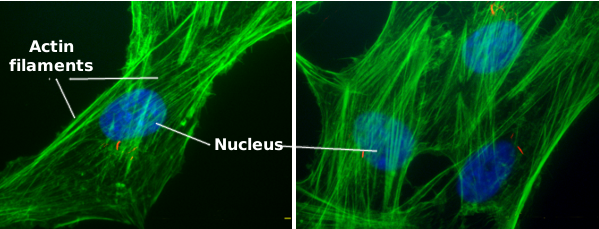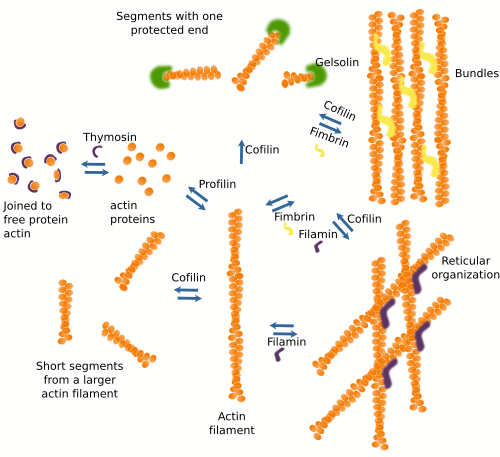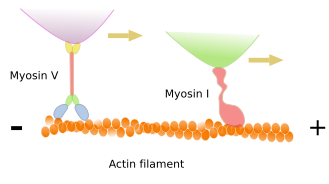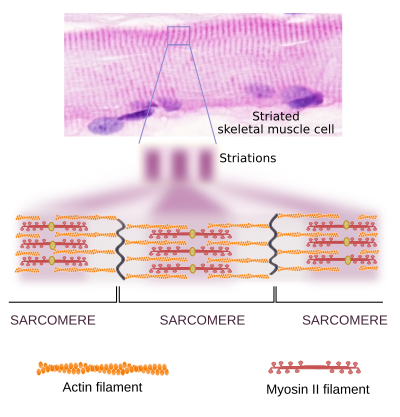Actin filaments are a component of the cytoskeleton. In animal cells, actin filaments are usually found near the plasma membrane (Figure 1), but their distribution and organization depend much on the cellular type. Actin filaments perform many functions in the cell, such as cell division, cell movement, endocytosis, phagocytosis, intracellular communication, and cellular scaffold.

1. Structure
Actin filaments are built by polymerization of globular actin proteins (Figure 2) . Actin is a very abundant protein in the cytosol, accounting for about 10 % of the total cytosolic protein content. In the total cytosolic actin protein pool, some are found as part of the actin filaments (known as F-actin), and the remaining are free in the cytosol (known as G-actin).

Actin filaments are 7 nm thick, thinner than the other cytoskeleton components (microtubules and intermediate filaments). That is why actin filaments are also known as microfilaments. Actin filaments have a minus end and a plus end, which means that they are polarized filaments. At the plus end, polymerization, the addition of new actin proteins, is more frequent than depolymerization, whereas at the minus end, depolymerization is more frequent. The increase and decrease in the microfilament length are caused by polymerization and depolymerization, respectively. In the cell, these changes are happening all the time. Actin filaments are the most dynamic components of the cytoskeleton.
The cytosolic environment and the concentration of free actin proteins in the cytosol prevent the spontaneous assembling of actin filaments. Hence, the formation of new microfilaments relies on nucleation protein complexes, such as Arp2/3 and formins. Thus, new microfilaments are formed when and where they are needed by precisely placing nucleation protein complexes.
2. Organization
A salient feature of actin filaments is that they are highly adaptable. They are formed and removed easily and associate with each other in many ways to form 3D scaffolds. This versatility relies on more than 100 different modulator protein types, or actin associated proteins. These proteins regulate filament polymerization and depolymerization rates, the nucleation of new filaments, the destruction of existing filaments, and 3D organization.
Proteins associated with actin filaments can be divided according to their functions (Figure 3). a) Modulate polymerization. b) Modulate the spatial organization. c) Break and rearrange the actin filaments. d) There are also proteins that act as intermediates between actin filaments and other proteins. e) Others are in charge of anchoring actin filaments to other cellular structures like membranes and other components of the cytoskeleton. Some actin associated proteins may perform more than one function. There are also drugs that influence the polymerization of actin filaments. For example, cytochalasin inhibits polymerization, whereas phalloidin inhibits depolymerization.é

3. Myosin
Many functions performed by actin filaments depend on the motor proteins known as myosins. These proteins can move cargoes along the actin filament toward the plus end. The energy comes from ATP hydrolysis. Besides dragging cargoes, myosins can also slide two actin filaments, one over the other, in opposite directions.
4. Functions
Cell shape
Underneath the plasma membrane, there is a cortical layer of actin filaments that makes cells both withstand and generate mechanical forces, influencing, in this way, the cell shape. Animal cells lack a cell wall, so that cell shape largely depends on the actin filaments of the cortical cytoplasm. In animal cells, the cell shape is also influenced by the adhesion contacts with the extracellular matrix and other adjoining cells. Tight junctions and adherent junctions are cell-cell junctions made up of adhesion connected to actin filaments.
Cell movement
Cells do not swim; they crawl or trail across the tissues. For cell movement, several steps are needed: the production and extension of cytoplasmic protrusions, the adhesion of these protrusions to some elements of the environment, and the drag of the rest of the cell toward these anchoring points. The cellular protrusions are known as podia, and there are lamellipodia, filopodia, and lobopodia. Actin filaments have a prominent role in the formation of these protrusions (Figure 4).

Internal organization
Actin filaments are mostly found near the plasma membrane, in the so-called cortical region. In this place, they are involved in vesicle formation, macropinocytosis and phagocytosis.
Organelles are moved through the cytoplasm. Actin filaments, together with myosin motor proteins, help with the organelle movements (Figure 5). This role is very important in plant cells.

Muscle contraction
In muscle cells, myosin II molecules join to form the thick myosin filaments, which show polarity as if they were an arrow with two arrowheads, each at one end (Figure 6). In the striated muscle, each of these heads drags actin filaments toward the middle point of the myosin filament. This is the molecular mechanism for muscle cell contraction.

Cytokinesis
During cell division, the final strangling of the cytoplasm is produced by a ring of actin filaments that, helped by myosin II motor proteins, gets progressively smaller in diameter until the complete separation of the cytoplasm of the two new cells.
Microvilli
Microvilli are filiform expansions of the apical part of some cells that enormously increase the surface of the plasma membrane. Each of these little expansions, or microvillus, contains several dozens of actin filaments oriented parallel to the longitudinal axis of the microvillus (Figure 7). At the base of microvilli, in the peripheral cytoplasm, there is a molecular scaffold known as the terminal web, which is composed of actin filaments and stabilizes the whole set of microvilli.

 Cytoskeleton
Cytoskeleton